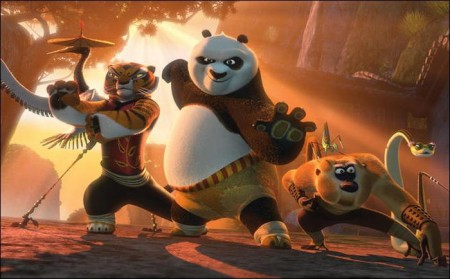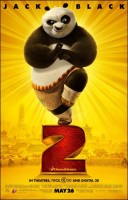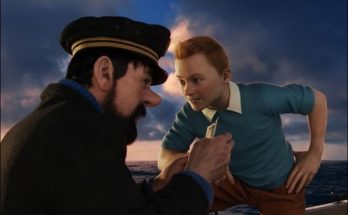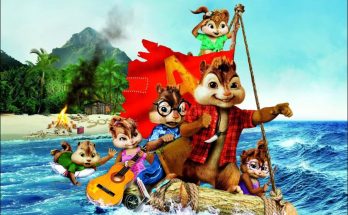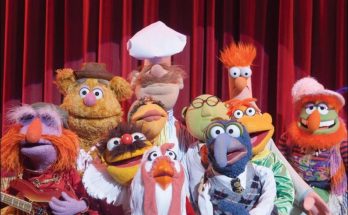Taglines: Prepare for the return of awesomeness.
In the Valley of Peace, Po Ping is revelling in his fulfilled dreams as he serves as the fabled Dragon Warrior protecting his home with his heroes now his closest friends. However, Po and company learn that the murderous Lord Shen of Gongman City is threatening the land with a fearsome new weapon that could mean the end of kung fu. They attempt to stop him, but the panda is burdened with crippling memory flashbacks linked to this villain. Now with China in the balance, Po must learn about his past and find true inner peace against all opposition.
In Kung Fu Panda 2, Po is now living his dream as The Dragon Warrior, protecting the Valley of Peace alongside his friends and fellow kung fu masters, The Furious Five. But Po’s new life of awesomeness is threatened by the emergence of a formidable villain, who plans to use a secret, unstoppable weapon to conquer China and destroy kung fu. Po must look to his past and uncover the secrets of his mysterious origins; only then will he be able to unlock the strength he needs to succeed.
The Golden Age Of The Panda Shines Brighter
Jennifer Yuh Nelson, the director of “Kung Fu Panda 2,” had three different titles on first “Kung Fu Panda” – Head of Story, Actions Sequences Supervisor and Dream Sequence Director. And just as Po followed his path to becoming the Dragon Warrior, Nelson had her own journey.
States producer Melissa Cobb, “Jen was there from the beginning, and was really instrumental in helping to shape the story. If there is anyone who knows this material, these characters and this world, it is Jen. Her becoming the director of ‘Kung Fu Panda 2′ was the most natural progression imaginable.”
Says director Jennifer Yuh Nelson, “I grew up with Hong Kong action movies, and I brought that sensibility as Head of Story on ‘Kung Fu Panda.’ I was pretty gung ho for all of us to be in that mindset, and I continued that push on this film. I think one of the keys is that we’re all conversant in that vernacular now. And in working on ‘Kung Fu Panda 2,’ that shared experience has come with us, and it informs the story we are telling and the manner in which it is told. Our goal was to take ‘Kung Fu Panda’ and Po to the next level.”
Just as Po has become a better warrior, his newest adventure reflects his deeper immersion into the world of kung fu. Per Nelson: “This film follows more in the tradition of martial arts movies—there are often questions that arise about a newly anointed hero’s past and there are those who seek to challenge his authority.
“Since the release of ‘Kung Fu Panda’, there has been one burning question that people are desperate to answer. The question that defies explanation is: Why is Po’s dad a goose? For Po, the Dragon Warrior, it was logical for him to finally realize his father is not his biological father and to seek his origin. While doing so, he learns his past is tied to Lord Shen. The peacock’s challenge is not random, it is the working of fate—something that also figures prominently in martial arts films. And it is only when he learns the truth about who he is that Po is able to confront Shen and his army.”
“In the first film,” continues Nelson, “we learned that heroes come in all shapes and sizes as Po fulfilled his destiny and became the Dragon Warrior. In the sequel, we learn that fate leads us to our destiny – bringing people into our lives that protect us and those that challenge us…allowing us to realize our full potential.”
Po’s story began in the summer of 2008, when DreamWorks Animation’s “Kung Fu Panda” hit motion picture screens around the globe. The tale of the day dreaming noodle maker with aspirations of kung fu greatness found a widespread audience who happily accompanied Po on his journey from kung fu super fan to kung fu hero. The action-packed family comedy grossed more than $633 million worldwide, was nominated for the Academy Award® for Best Animated Feature Film and took home 10 Annie Awards (the animation industry’s highest honor).
States producer Cobb, “With the first film, we really did set out to make an animated movie that people could enjoy with their families for years to come. We were intent on making a film that felt timeless, while being respectful to the kung fu action genre. We knew when we made the first film that we created a character with a lot of depth and levels of story we weren’t able to touch on. What we have in the sequel is the evolution of a hero—which isn’t a straight path, or a standard arc. And evolution takes time, so we’re committed to going with Po on his journey. When ‘Kung Fu Panda 2′ started to take shape, it was an organic extension of the story that we began.”
‘Kung Fu Panda’ screenwriters Jonathan Aibel and Glenn Berger were thrilled to return to continue Po’s story. Aibel sums up the thoughts and feelings of the creative teams when he offers, “Working on the first, it was fantastic, a giant collaboration. I think the best thing we can say about the group of people working on the first movie is that they all wanted to be a part of the second movie. That’s pretty rare in Hollywood…I mean, the heads of nearly every department on this movie were in the same job on the first movie. People say once they started working for Po, they didn’t want to leave.”
“I think that also means,” Aibel continues, “that a lot of our time was spent on the first movie laying the groundwork for the environment and building the characters and now, a lot of that creative energy was freed up to push the limits and see how much more fun we could have—this meant bigger action sequences, deeper character work, a larger look at this amazing world.”
Joining those already mentioned, among the ranks of film artisans returning to “Kung Fu Panda 2” are: production designer Raymond Zibach; head of character animation Dan Wagner; editor Clare Knight; art director Tang Kheng Heng; composers John Powell and Hans Zimmer and supervising animator, kung fu choreographer and storyboard artist Rodolphe Guenoden, among others.
Mysteries OF The Dragon Warrior Revealed
Screenwriters Aibel and Berger had joined filmmakers on the first film to focus the story—with the whole of a fictitious ancient China and a pantheon of kung fu characters to choose from, early work on the screenplay had produced an almost embarrassing amount of riches. It was Aibel and Berger’s job to refine the story, bring it back to Po and his legacy, and help define the story’s tone. As their final script did just that, their services were retained to pen “Kung Fu Panda 2,” as both writers and co-producers.
Cobb offers, “When you become enmeshed in the development of a character, there is no ‘stopping place.’ We always imagined we had more story to tell with the continuation of Po and his journey.”
Aibel claims, “When you love your work as much as Glenn and I loved working on Po and Shifu and all the others, your brain is constantly churning out story possibilities—and since we were there when the groundwork was laid, we know the characters inside and out, so getting to take them further is another great day at the office.”
Berger offers, “Just as Po is getting comfortable in his new role as Dragon Warrior and leader of the Furious Five, a turn of events takes place leading Po to ask questions he never thought to ask. Where did he come from? How did he get there? And why is his dad a goose and he’s a panda? And unfortunately, Dad doesn’t have much to offer by way of answers for Po. So Po spends the rest of the movie trying to answer those questions—and what he discovers will change their relationship forever.”
When work began in earnest on the first film, there was no parental figure for Po. As the story developed, the writers felt that such a role was necessary for the panda’s story. So how did they choose Mr. Ping, the goose, for fatherhood? As Jonathan Aibel explains, “The obvious choice would be to just give Po a panda dad, but we always knew we wanted Po to be the only panda in the village.”
Glenn Berger picks up, “So we asked the animators, ‘What do you have?’ And we saw there were bunnies, there were ducks and there was this goose. And we thought, ‘What if the goose was his dad? But how could that be?’ Then that just led to all these questions—maybe Po doesn’t know that this is not his biological father, or maybe he does know? It basically forced us to make a more unusual choice, and I think we then all got to explore what would happen if Ping were Po’s father. In the end, I think it made for a more interesting movie.”
For Jack Black, returning to the character of Po was a chance to spend more time with one of his most beloved characters. Thanks to Po, Black had the chance to kick off the 2008 Cannes Film Festival (“Kung Fu Panda” was the first film screened), by leading a parade of marchers dressed in panda costumes.
Black recalls another unique opportunity his relationship with Po afforded him: “A few months ago, I got to go to the Atlanta Zoo, and see the latest panda born in captivity…and they named him Po. Wow. I’d say that’s a pretty big deal. He’s not ready for a throw-down yet, but give him time. He’s gonna be one heck of a panda, I just know it.”
Black recalls, “When I finally saw the whole thing put together (Kung Fu Panda) it was one of the proudest moments of my career. It takes many years to make one of these movies – a lot longer than a regular live-action film. There’s much more work that goes into it – story development, artwork, particularly the way the DreamWorks Animation filmmakers work on their films.”
But for the actor, it was also a chance to bring more of his character to light. “Now, Po is having flashbacks of his childhood, before he lived with his father, who’s a goose. So he comes to realize that he’s actually adopted, and he doesn’t know where his birth parents are or what happened to the other pandas. Why did they give him up? So in addition to this being a hero’s journey to save the day, it’s also a journey of self-discovery.”
For even the most casual of observers, it’s evident that Mr. Ping, a noodle-making goose, is not Po’s biological father, but the story does address exactly what makes a parent. Per Black: “Once Po suspects that he’s adopted, he confronts his father, who admits that he found him when he was a baby. But he raised him as his son, and he considers him his son. Po believes that, too, but he still wants some questions answered. And it just so happens that these questions arise at the same time that a new villain, Lord Shen, the peacock, arrives on the scene. Mysterious, no?”
Black, who gained a much deeper appreciation of martial arts due to his involvement with the franchise, admits to practicing kung fu: “Yes, I did some training in kung fu, for both films. It wasn’t just for research purposes, it was also to kind of get in shape. What really drew me is that there’s a combination of exercise and self-defense, along with a third, sort of unseen, component: a spiritual one. When you’re really practicing kung fu, living it and feeling it, there’s a meditative quality that seeps in. It feels almost religious. It’s an art form, really. Oh, well, duh, it’s called martial arts.”
Now a package deal, the Dragon Warrior comes with the Furious Five—and writers Aibel and Berger were more than happy to welcome the entire gang back. Per Berger: “In the first film, we were busy telling the story of Po’s training with Shifu, so we didn’t get as much time as we wanted to with the Furious Five. But now, we have the great opportunity to have them along on this journey with Po and have them in more scenes, which meant more time to write for Angelina [Tigress], Jackie [Monkey], Seth [Mantis], Lucy [Viper] and David [Crane]. For any writer, any one of those would be enough. But to have five of them along in all these scenes is just a great opportunity for us.”
As Tigress, perhaps the most accomplished fighter of the Furious Five, Angelina Jolie was also happy to return, and like Black, was enthusiastic when she found out that her character would be undergoing some changes as well. Jolie says, “First and foremost, Tigress is a fighter, and she’s out to get the bad guy. But what’s nice about this story is that she has a bit of a breakthrough and learns to be nicer. Her pride was wounded when she was not chosen to be the Dragon Warrior, and it took her a while to get over being angry at Po and the universe, in general.”
The writers enthusiastically created new facets in Tigress that gave Jolie more to explore this time around: “What if Tigress had this softer side to her? To be able to give that to Angelina and see what she did with it was great to witness. Sometimes, it takes an animated character to show a different side of an actor. As a voice performer, you’re free from people’s expectations of what they’ve seen from you in live-action films.”
“She’s such a pure, beautiful character,” the actress continues. “She was written with such an interesting history. She comes from an orphanage, she grows up not knowing her own strength or understanding herself—but then she grows into this very strong woman, the others call her ‘hardcore.’ But she just doesn’t have the ability to access her softer side and emotions—maybe a measure of self-protection. And I think that’s why some people identify with her.”
Proud As A Peacock, Tough As A Warrior
In our world of ancient China—the version that serves as home to the characters of “Kung Fu Panda 2”—fireworks, or sky flowers, were the dominion of the ruling peacocks, until a son in line for the throne saw their potential for destruction. In turning the purpose of fireworks from constructive to destructive, the peacock named Shen sets his own course toward darker purposes…and, inadvertently aims his life’s path to eventually cross with a panda named Po.
Jonathan Aibel explains the genesis of Shen: “When we first started working on ideas for the sequel, we knew that we had already created a fantastic villain in the first film with Tai Lung—he was the ultimate in kung fu strength and Po’s victory over him was a victory of softness over hardness. We felt we couldn’t top Tai Lung if we tried to come up with an even stronger villain, so we thought, ‘What if we tried to make this villain more threatening in an intellectual and an emotional way?’ So that’s how we came up with the character of the albino peacock, Lord Shen.”
The director interjects, “For the villain in this film, we went a completely different way from Tai Lung, who was hardcore, full-on strength and brutality. And we couldn’t really go much stronger than he—Tai Lung could punch his way out of a mountain. So we looked for someone more threatening in a different way—more intellectual, smarter, devious. Po has learned to master the art of kung fu, so something was needed that could trump ability. Lord Shen is, at first, an unimposing-looking guy. He’s a white peacock, after all, not much of a threat, right? Well, in addition to his fighting skills, which are imposing, he also has speed, and all of that is backed up with weaponry. He’s sinister and scary in his own way.”
To voice such a clever, flamboyant and accomplished bird as Shen, filmmakers sought out one of the best and most versatile character performers working in entertainment: Gary Oldman.
“Among Gary’s amazing performances,” points out the director, “are several who could be called villains—and yet, they possess so much charm and bearing that their villainy almost becomes secondary. His work in ‘Bram Stoker’s Dracula’ shows us the human heart of the monster. We felt that his skills would elevate Shen from a character simply driven by vengeance to a really interesting, multi-layered soul. Evil is so much more alluring when it’s painted with a full spectrum.”
The producer adds, “Gary has such a great voice that can communicate gentleness and soul one minute, and spine-chilling evil the next. That combination really serves Shen. He gives him an amazing emotional intensity.”
“I love the challenge of conveying a character fully just using the voice,” explains Gary Oldman. “And Shen is a particularly interesting character. His cleverness led to a miscalculation, and what he had hoped would be an invention worth celebrating turned out to be a weapon that inspired fear. It’s that moment when a child, who is immensely proud of something, finds out that what he has accomplished is deemed wrong. That makes for a great deal of hurt—not only does he want to prove himself right and worthy, he wants to take those down who stood in his way in the process. He has come back to take what is rightfully his. I think he fits very nicely in the gallery of Oldman villains.”
Co-star and leading panda Jack Black echoes the praise of his director and producer: “The villain this time around is an evil peacock and it’s played by one of my favorite actors of all time, Gary Oldman. I’ve always drawn a lot of inspiration from his performances, way back to ‘Sid and Nancy.’ And to see all of the different villains that he’s played? Probably my favorite is ‘Dracula.’ In the scene where he’s with the white wolf, and he says to the girl, ‘He likes you.’ There’s something almost delicate about the evil in that scene that was really amazing. I was really excited when I heard he was playing Shen.”
“Pride has been called many things and has carried the blame for some of the worst in man,” muses Oldman. “And Shen is proud—he’s a peacock, so it’s almost in his DNA. That pride, though, if it were matched with some humility or compassion, he would actually make a formidable leader. But, as it stands, he makes for a rather nasty opponent.”
Leading Shen’s army of lupine forces is the aptly named Wolf Boss, voiced by Danny McBride. Notes the actor, “He’s pretty fierce and cool—and I think what really makes him awesome to play is that he only has one eye. That is always shorthand for someone who is tough. Anyone in a Western missing an eye is someone to be reckoned with. Who doesn’t want to play the big, bad wolf?”
Michelle Yeoh is no stranger to big, bad villains, or martial arts films (although “KFP2” is her first animated martial arts entry). Never professionally schooled in martial arts, the performer used her early dance training to take full advantage when she began making action films for a Hong Kong-based company in the mid ‘80s. Already a respected performer outside of the United States, Yeoh’s domestic popularity skyrocketed with her performance in Ang Lee’s lyrical “Crouching Tiger, Hidden Dragon.” In KFP2, Yeoh was cast as the voice of the Soothsayer—a wise and ancient big-horned sheep that is close in character to the witches in “Macbeth,” and her visions come to influence (if not out and out determine) some of the key plot points in the film.
Yeoh comments, “I did ‘Crouching Tiger’ because I felt that the genre needed more respect and dignity than it had been afforded. It is steeped in history and our culture—I think it really opened eyes in Western audiences. And I feel that the ‘Kung Fu Panda’ films do the same thing, in a way. Whether people realize it or not, they are being exposed to aspects of Chinese culture, martial arts and legend. And it’s done in such an enjoyable way that it doesn’t feel anything like a lesson or a classroom learning experience. I think they’re wonderful entertainment, and I was very glad to be asked to be in this one.”
Kung Fu Panda 2
Directed by: Jennifer Yuh
Starring: Jack Black, Angelina Jolie, Jackie Chan, Dustin Hoffman, Gary Oldman, Lucy Liu, Seth Rogen, Michelle Yeoh
Screenplay by: Jonathan Aibel, Glenn Berger
Production Design by: Raymond Zibach
Film Editing by: Maryann Brandon, Clare De Chenu
Art Direction by: Tang Kheng Heng
Music by: John Powell, Hans Zimmer
MPAA Rating: PG for sequences of martial arts action and mild violence.
Studio: DreamWorks Pictures, Paramount Pictures
Release Date: May 26, 2011
Hits: 121
